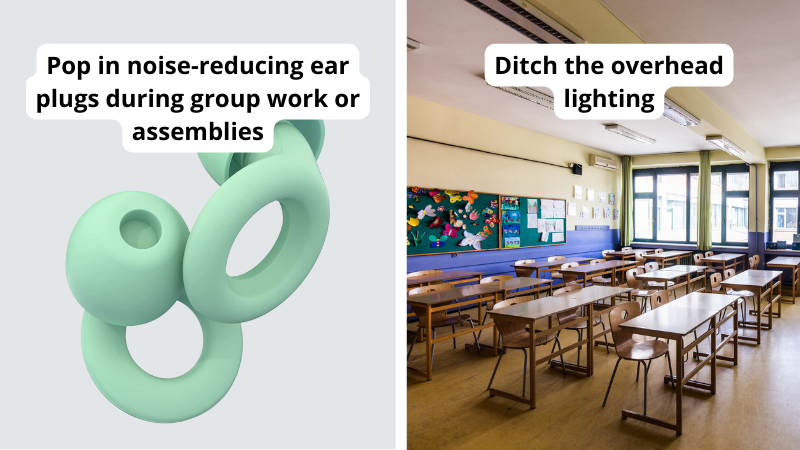Teachers are exposed to a lot of sensory stimuli on a daily basis. Pre-K hugs that come up to our knees. Sunshine glinting off puddles at recess. Getting a whiff of the pages from a book from 1983 in our classroom library.
Of course, not all sensory experiences at school are positive.
The screeching din of a full cafeteria. A rogue foam dodgeball nailing you in the side of the head. The distinctly middle school–age smell of onion-y body odor plus any number of cloying body sprays. The day the science team does a balloon car experiment.
While sensory overwhelm is a term often associated with people who have sensory-processing issues or sensitivities due to conditions like ASD, ADHD, or SPD (sensory processing disorder), sensory overwhelm can happen to anyone. How do you know your senses are overwhelmed?
- You might be extremely irritable.
- You might be unable to focus.
- You might have a strong urge to remove whatever stimuli is sending you into overdrive.
- You might have a strong urge to remove yourself from the situation.
Sound familiar?
I polled a group of teachers for their top suggestions on reducing sensory overload while at school, and they came through with a ton of responses. Check out their teacher-tested suggestions for ways you can reduce the stress on each of your five senses, as well as help manage situations that create multi-sensory challenges.
Hearing
1. Noise-reducing ear equipment for class, cafeteria, assemblies, etc.
“I wear Loop earplugs! Sometimes I even wear my full-on over-ear ear defenders. I have chronic migraines and am also neurodivergent. I explain to my students that they’re not earbuds or headphones and that I’m not listening to music—rather, sometimes I just need to turn down the volume a little on everything. Yes, I can still hear you (they like to whisper to test this, haha).”
—Ante S.
Buy it: Loop Quiet earplugs on Amazon
“Ear plugs during prep blocks and assemblies.”
—Michelle
2. Play nature sounds, white or pink noise, or beta waves
“Nature sounds. I could be imagining it, but I swear my classes are quieter when I have them playing during the day.”
—Katie W.
Touch
3. Fidgets (for teachers!)
“I have a calm strip metal tag on my lanyard that I can fidget with when anxious.”
—Ante S.
Buy it: Calm strips and calm strips with metal tags on Amazon
4. Make time for being outside
“OK, admittedly I am extra crunchy, but I practice grounding every day during my lunch break. Shoes off, stand on the grass, set a timer for 10 minutes. Eyes closed and deep breaths. My team and students give me so much grief for it, but I swear it does wonders!”
—Georgia L.
“Finding a quiet spot to sit outside in the sun.”
—Alex F.
5. Discover soothing routines for your sense of touch
“I have ASD and have learned that my sense of touch is my top way to calm down. I have a heated blanket for winter months and a light blanket for warmer months that I wrap up in during my planning period or when I’m seated. In my desk, I keep fidgets, “crunchy” slime, and a neck wrap I can pop in the microwave. Sometimes just a break to wash my hands with fancy soap I bring from home is enough.”
—Julie F.
Buy it: Neck wrap on Amazon
Taste
6. Keep a soothing beverage within reach
“Tea all day.”
—Cora
“Peppermints followed by cold water! For some reason this … IDK, drowns out everything else? It’s like a hard reset for my brain.”
—Erin O.
Smell
7. Reset your olfactories
“Open the windows (or go outside during your break) to reduce the smell of teenager.”
—Catie G.
“I keep an essential-oils roller to smell when I need a peaceful moment.”
—Dani P.
Buy it: Essential-Oils Roller Set on Amazon
Sight
8. Make changes to your lighting
“Just say no to overhead lights.”
—Marjorie L.
“I use rice paper balls, lamps, and sunlight for lighting.”
—Cora
“Dim your Smartboard.”
—Isabel B.
9. Try to eliminate wall clutter
“Don’t overcrowd the walls. Plenty of blank space. This is good for me AND the students.”
—Cami C.
Check out more minimalist classroom design tips here!
Multi-sensory
10. Create a soothing environment for your prep period and breaks
“My prep period is sacred. Quiet time, lights dimmed.”
—Krissy
“Not allowing any kids in my room during lunch or my planning period.”
—JMM
“Reading a fun novel on my break. Kept me off my screens and gave me something regular to look forward to.”
—Allie R.
11. Opt for a solo lunch
“I’ve had to resort to quiet lunches instead of eating with other teachers. It gives me time to decompress.”
—Jacki B.
12. Teach classroom routines and practices that reduce sensory overload
“Strong systems in my room for movement and voice level!”
—Beth A.
“DEAR (Drop Everything And Read) time where the lights are off, they are quiet, and I am drinking coffee and resting at my desk. Repeat as necessary.”
—Reale K.
“Have students write me a note and place it on my desk so I can address it when I have a moment instead of pausing the lesson or having to address it while teaching. Students feel heard and are able to explain, and I can address it on my own time.”
—Emily H.
13. Know your scheduling limits
“I would get so stressed out when I had parent meetings scheduled just before my next class. Even if it wasn’t a tense meeting, the stress of having a meeting and class back-to-back would totally ruin the rest of my day. I began only offering a time slot to parents that gave me 10 minutes to wind down from the previous class and 10 minutes to gather myself before the next class.”
—Sarah K.
“I have a teacher who advocated for herself to get a hallway post vs. cafeteria during lunch—so smart to know yourself and ask for what you need! (We happily granted this request!)”
—Maggie M.
14. Set boundaries with your students
“I think it’s a good practice to set norms and boundaries for yourself with your students. ‘Here’s a good distance to be away from my face when you come ask me a question.’ ‘Here’s how I’d like you to ask a question. I don’t like to be tapped on the shoulder.’ Then they feel empowered to set boundaries too.”
—Julie P.
“Honestly, I tell the kids that I need to regulate my body because I’m starting to get deregulated. And then we breathe and count together so that we can ALL get ourselves grounded and regulated again.”
—J.L.
15. Reevaluate the way each class begins
“Soft start! First 10 minutes they can finish/do the homework, ask me questions, draw, chat, whatever, as long as it’s calm.”
—Jacqueline W.
“I really try to have kids be silent during the entry task. Helps with a focused start to class and lets me get my head on straight and take attendance.”
—Hannah F.
The beauty of these strategies is that many of them can help with sensory issues your students might have too.
Here’s to creating a calmer, more soothing classroom and school experience.
How do you reduce sensory overwhelm for yourself or your students? Let us know your thoughts in the comments.
Looking for more articles like this? Be sure to subscribe to our newsletters!


